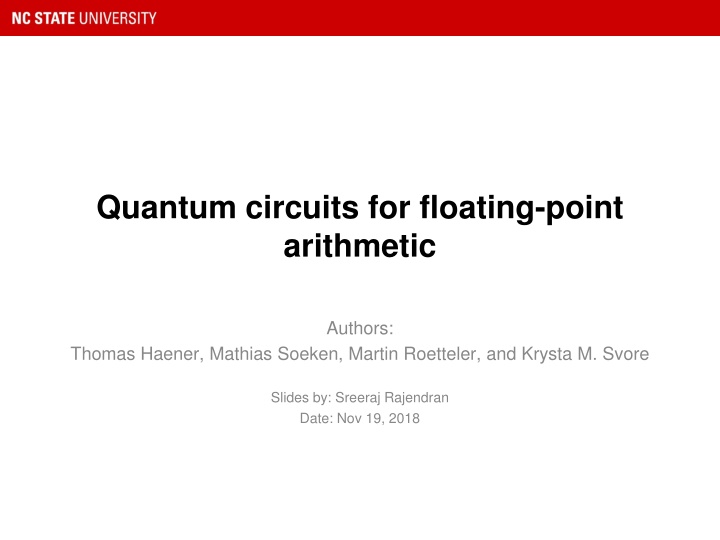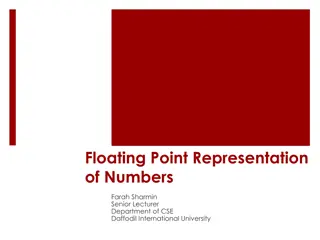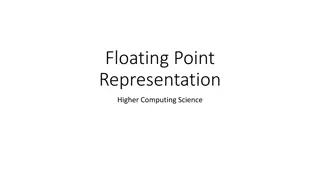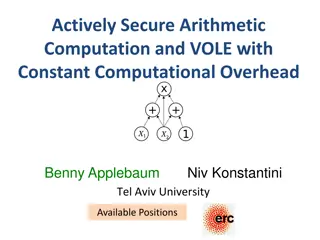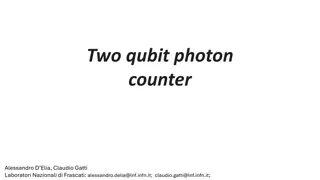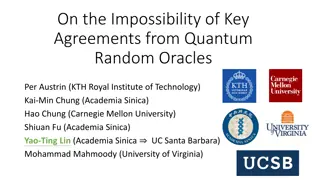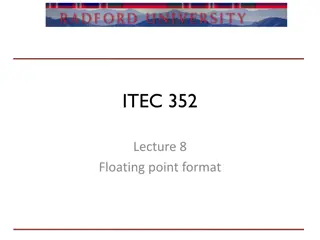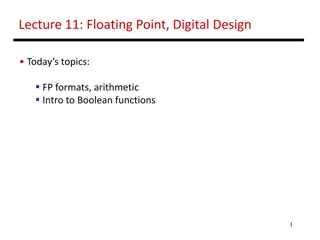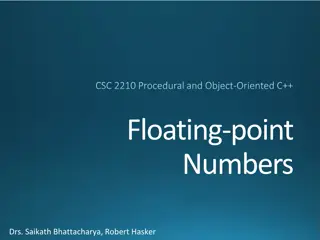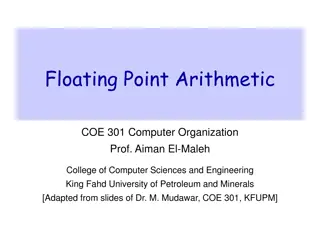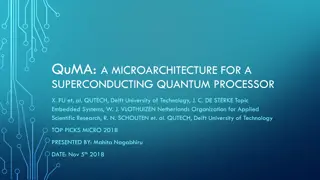Quantum Circuits for Floating-Point Arithmetic Study
This study delves into the impact of different floating-point representations on quantum circuits, focusing on efficient hardware-software co-design for computation-intensive applications like quantum machine learning and quantum field theory.
Uploaded on Mar 01, 2025 | 0 Views
Download Presentation

Please find below an Image/Link to download the presentation.
The content on the website is provided AS IS for your information and personal use only. It may not be sold, licensed, or shared on other websites without obtaining consent from the author.If you encounter any issues during the download, it is possible that the publisher has removed the file from their server.
You are allowed to download the files provided on this website for personal or commercial use, subject to the condition that they are used lawfully. All files are the property of their respective owners.
The content on the website is provided AS IS for your information and personal use only. It may not be sold, licensed, or shared on other websites without obtaining consent from the author.
E N D
Presentation Transcript
Quantum circuits for floating-point arithmetic Authors: Thomas Haener, Mathias Soeken, Martin Roetteler, and Krysta M. Svore Slides by: Sreeraj Rajendran Date: Nov 19, 2018
Contents Motivation Background Hand-optimized Circuits Automatic Circuit Synthesis Analysis Conclusion Feasibility
Motivation Floating point can support a much wider range of values than fixed point, with the ability to represent very small numbers and very large numbers. Dynamic range is especially important when processing extremely large data sets or data sets where the range may be unpredictable. Hence, ideal for computationally intensive applications like Quantum Machine Learning. Algorithms that focus on physical phenomena, such as quantum chemistry and calculations seem especially likely to be able to take advantage of floating point arithmetic. quantum field theory
Motivation Study the impact of different choices of floating-point representations on the number of quantum bits (qubits) and number of T-gates that are required for basic arithmetic operations. Great savings in number of qubits compared to fixed point representation when the required range of values and/or relative precision is large. Efficient hardware-software co-design : It is crucial to analyze the resulting circuits in order to acquire resource estimates.
Background Floating point representation: Every number x is approximated using three registers: 1 sign bit xS, M bits for the (non-negative) mantissa xM ([1, 2)), and E bits for the exponent xE. Addition
Background Multiplication: Multiplication:
Background Quantum Circuits Every quantum instruction must be reversible Intermediate results need to be stored in ancilla qubits Quantum Error Correction : all quantum operations need to be mapped to a discrete gate set (Clifford+T) T-gate - most expensive quantum operation Circuit size: KQ= T-depth.#Qubits T count: number of T gates ( 7) T -depth : number of T-stages(6)
Hand Optimized Circuits Building blocks: Circuit for finding the first one in the bit-representation of x. f is toggled on finding first 1 and position of the first one is stored in the p-register. QUIRK Shift circuit for an 8-bit number x. The shift s must be such that the top, i.e., least-significant s bits of x are 0. Shift_circuit
Hand Optimized Circuit: Addition Circuit Sort inputs by exponent : CMP +SWAPs Shift 2ndmantissa by difference of exponents Add 2ndmantissa to first and convert back from 2 s compliment If carry, shift result by 1bit and increment exp by 1 RN gate renormalize the intermediate result using first one ckt followed by shifting the mantissa by the output of the first-ones circuit and copies out the resulting floating point representation.
Hand Optimized Circuit: Multiplication Circuit Multiply input mantissas (Mx and My) into new register of 2m qubits Right shift by 1 if Mx.My>=2 Update exponent Add input exponents Ex and Ey to Ez if Mx.My!=0 COPY: copying out of the resulting exponent, mantissa and sign bit to take care of special cases such as over- and underflows in computing the resulting exponent which turn to infinity and zero outcomes, respectively
Automatic Circuit Synthesis LUT based hierarchical synthesis approach (LHRS) Input - classical gate-level logic network (Verilog file) Apply logic synthesis algorithms to map the gate-level netlist into a LUT(lookup table) network. There is a one-to-one connection between a k-input LUT in a logic network and a reversible single-target gate with k control lines in a reversible network. Single-target gates: reversible gates in which the value of a target line is inverted if a given Boolean control function evaluates to true on the control line. Translate into a reversible network composed of single-target gates. Each single-target gate can be synthesized into a quantum circuit using techniques such as exclusive-sum-of-product decomposition. (ESOP)
Automatic Circuit Synthesis Aim: find a reversible network with as few ancillae as possible Each single-target gates is mapped to a Clifford+T network For each single-target gate, all available mappers were implemented and the quality of resulting Clifford+T networks were compared
Comparison of Resource Counts Resource counts for Hand Optimized Circuit Resource counts for Automatically Generated Circuits
Analysis: Disadvantage of Automatic Synthesis cost in handcrafted floating-point circuits are much lower than automatic synthesis tool Optimization function is based on classical problems where in the objective is to minimize time and bits are available in plenty. It also highly depends on the logic network that is input to the synthesis algorithm. The relation of this objective to the number of qubits and T-count is not fully understood.
Analysis: Advantages of Automatic Synthesis Automatic synthesis can be applied to various designs and results can be obtained immediately compared to several months in case of hand crafted. Adjustable synthesis parameter : various different implementations of the same design can be found. Design space exploration: depending on the targeted quantum platform or the context of the design inside a quantum algorithm, one can address different objectives. Potential to find a design that requires fewer qubits. Automatic synthesis techniques can in principle find quantum circuits without any ancilla qubits (except to store the result of the outputs)
Feasibility Floating-point arithmetic using hand-optimized circuit for quantum computing is viable. Automatic synthesis results in v.large circuits. Circuit size, KQ= T-depth.#Qubits improvement over previous work (KQ=723,301) Cost of floating-point multiplication is very similar to performing it in a fixed-point representation <= 439,320 : 39.3% floating-point multiplier can deal with a much wider range of values at constant relative error
Conclusion The manageable and incurs almost no overhead for typical scientific applications. For many quantum algorithms, the extra range and constant relative error offered by a floating-point representation are well worth an increase in circuit size of 2-3 . cost of using floating-point arithmetic is
Discussion Larger overheads compared to fixed point arithmetic is partly because of strict requirements of IEEE standards for floating point arithmetic. In combination with manual circuit optimization, relaxing the requirements allows for significant savings size of the circuit. Differences in objective process for classical and quantum computing. Future scope: investigate approaches. Some of the subroutines in hand optimized circuits can still be further optimized using methods from the automatic synthesis approach. functions in optimization this combination of
